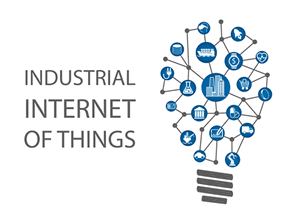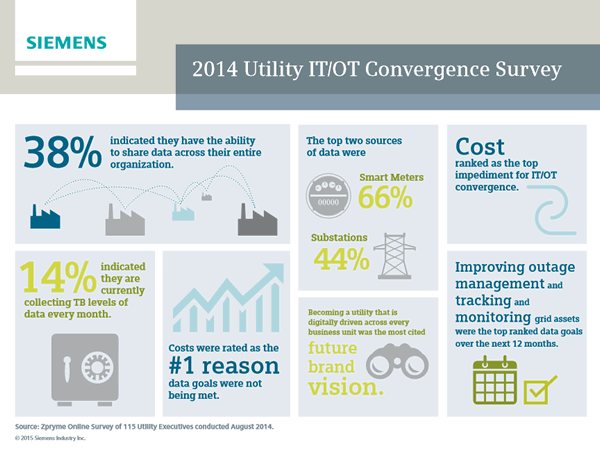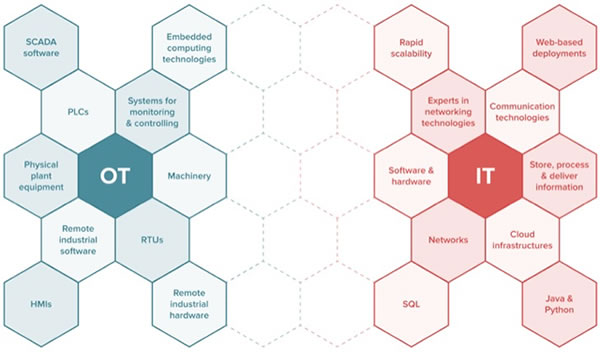
Back in 2011 Gartner advised (IT) leaders to prepare for the transition of their organizations to the converging, aligning and integrating of IT and OT environments.
Today it is the cornerstone of Industry 4.0, the industral Internet, cyber-physical systems and evolutions in areas and markets such as building management systems, smart metering and critical power.
In fact it’s one of the essences of the IoT (although IT and OT convergence goes back earlier, certainly in some of the just mentioned areas). Yet, with IoT is happening faster and at a broader scale than before and Gartner’s words become more actual than ever.
With IT and OT converging, the scope of CIO authority may cater to the needs of planning and coordinating a new generation of operational technologies alongside existing information- and administration-focused IT systems (Gartner)
In case you’re not familiar with the – by now – ‘good old’ IT versus OT debate: IT is what you think it is. Information technology or the corporate IT team, led by a CIO. OT is operational technology as we’ll see but it’s in the mix of both that interesting things happen. Of the previously mentioned markets IT and OT integration is, for instance, key in building management in the age of IoT.
As you probably know the role of IT and of the CIO has been changing for quite some years now (with discussions on multiple forms of IT such as bimodal IT as Gartner calls it and the business role of the IT chief), among others due to the famous increase of IT spending by divisions other than IT itself.
IT and OT: a distinction that decreasingly is one
OT has nothing to do with all that but it does add to the discussions on the (future) role of the CIO and IT. OT stands for Operational Technology. As the word says it’s all the technology that you use to run the operational side of your business, traditionally with little IT involvement. In practice we mainly speak about that convergence of IT and OT in the Industrial Internet of Things, Industry 4.0 and in industries such as utilities, manufacturing, etc.
Think about all those high-tech machines on the factory floor, your fleet of trucks and anything that has four or more wheels and is used for highly technical purposes, drills, industrial robots (where the integration of IT and OT is key in the Internet of Robotic Things), whatever fits in the context of your (operational) business and industrial activities and assets.
The convergence of IT and OT in IoT has been going on for a while and there isn’t a strict division between them in the real world.
In many businesses with lots of heavy machinery or other forms of OT, CIOs and IT departments will often be closely involved because of the critical role of all that technology, de facto technological convergence and integration (with the network being a first driver when many of these industrial assets started being seen as less stand alone than before) and the ways OT is being looked upon from the same view as IT in regards with, for instance, security.
Still, in some areas the distinction is clear. You won’t quickly see an IT worker repair a high-tech oil drill and, the other way around, you won’t see an engineer who takes care of the technologies to assemble cars, sit in a meeting on using predictive analytics to protect the corporate network from cyberthreats. But, as said, the lines between both do blur and the Internet of Things is no stranger to that evolution.

How the Internet of Things brings IT and OT together
You now can imagine why the whole debate on ‘IT versus OT’ or, more correct, the convergence of IT and OT, has been mainly held in specific industries and business functions, with the Industrial Internet (or Industry 4.0) being most involved.
We already mentioned some industries (manufacturing, utilities with, among others smart grid) but also think logistics, smart buildings, and mining, to name a few.
When looking for an image and as way of an example we found this 2014 blog post, infographic and study by Siemens in the utility space where Siemens identifies cost and interoperability are the biggest challenges in the convergence of IT and OT but where the need to get IT and OT out of their separate and traditional silos in order to reap the benefits of advanced metering and smart grid systems is stressed.
Now, how does the Internet of Things come into the picture? In a post, on the advent of the DX economy, we looked at some predictions by IDC for 2016 and beyond (with beyond being that DX or digital transformation economy).
Among the ‘most fertile areas for DX’, as IDC puts it, will be the Internet of Things. That is probably not a surprise. As mentioned, the Internet of Things today de facto is mainly ‘happening’ in industrial environments with the Industral Internet of Things (IIoT).
And it’s exactly in these industries where, among others, IDC also expects most IoT development to happen, at least in the next few years and even if IoT devices and solutions, we quote, “have the potential to redefine competitive advantage in virtually every industry”.
The link between the Internet of Things and the IT and OT debate is clear. After all, the IoT is mainly about automating processes using connected devices with a capacity to gather, receive and send information, embed intelligence and connectivity into devices and set up processes and applications that open up a realm of new possibilities with the proper tools to analyze data, automate and ‘write’ applications and develop APIs, putting these devices at work.
Utilities are realizing that to reap the full benefits of advanced metering and smart grid systems, IT and OT must work together (Lisa Caswell, Siemens)
Managing the exploitation of IT and OT when IoT drives transformation
As we are talking information, networks, connectivity, data, ecosystems and apps, we are talking IT, especially as all this connectivity and certainly, data and information (IT still stands for Information Technology) needs to be managed, secured, stored, processed, routed, leveraged and so on.
In an ‘industrial’ context it’s not different. It’s an environment where software and developers also find fertile ground (think connected cars and their software updates), as do IT experts with their knowledge of code (another big one in the evolution towards the DX economy according to IDC) but certainly also experts in typical IT areas such as security, a major concern in the context of IoT.
As we’re still relatively early in the whole IoT evolution but evolutions occur rapidly, the call for the convergence of IT and OT gets louder. In many industries IT and OT convergence already happens since quite some time (oil and gas is just one of the many, on top of the previously mentioned ones), yet in practice it remains a challenge in IIoT developments.
So, it’s not a coincidence that IDC highlighted the integration of IT and OT at the technology, process, security and organization levels as a key success factor and key evolution/prediction.
In the meantime here is a quote from Gartner’s mentioned 2011 press release on the convergence of IT and OT: “With IT and OT converging, the scope of CIO authority may cater to the needs of planning and coordinating a new generation of operational technologies alongside existing information- and administration-focused IT systems”.
Gartner also stressed how the key change for CIOs may be that their role moves from leading the IT delivery organization to leading the exploitation of the business assets of processes, information and relationships across all technologies in the enterprise — IT or OT, whether delivered, supported, or managed by the formal IT organization or elsewhere.
Convergence of IT and OT, with all the challenges and functional questions it implies, is simply a must in the IIoT.
The graphic below, from the Industrial Ethernet book, shows various components of IT and OT.
As the author says, that convergence (challenge) is not just one of technologies but also about new ways of thinking, which tends to be a challenge indeed when two different worlds, which have worked separately and with completely different systems, technologies and vendors, (have to) collide in the context of IIoT and the Industrial Internet.

All images are owned by the mentioned companies and/or sites, serving as an illustration. Top image purchased under license from Shutterstock

